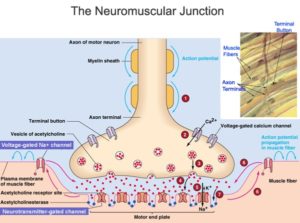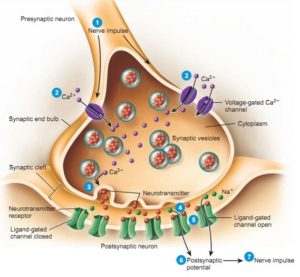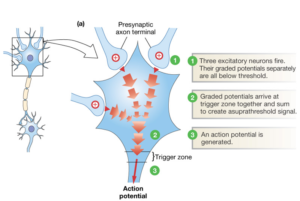Organisms respond to changes in their internal and external environments (AQA A2 Biology) PART 5 of 9 TOPICS
|
Synaptic transmission:
The structure of a cholinergic synapse and neuromuscular junction should be known. The acetylcholine receptor in the first image on the left is more better known as nicotinic cholinergic receptor.
In a cholinergic synapse (this is the only synapse you need to know) an action potential increases permeability of the presynaptic membrane by stimulating the Ca2+ ion gated channels to open. This causes an influx of Ca2+ ions into the presynaptic knob down its concentration gradient by facilitated diffusion. The high concentration of Ca2+ ions causes the vesicles of acetylcholine (neurotransmitters) to fuse with the presynaptic membrane. NB: It is best to say acetylcholine than Ach because it gives you more of an understanding and helps with questions if it says ‘acetylcholine’ instead of Ach. If you are going to use Ach it is important that you know what it is. Acetylcholine leaves the presynaptic knob by exocytosis into the synaptic cleft. Acetylcholine diffuses across the synaptic cleft and binds to the cholinergic receptors causing the Na ligand gated channels to open. This causes an influx of Na+ ions into the postsynaptic neurone making the postsynaptic neurone depolarised and if the threshold is met, an action potential is generated. The acetylcholine is removed from the synaptic cleft by the enzyme acetylcholine esterase into products by complementary shapes to prevent a continuous impulse. NB: Acetylcholine esterase can be abbreviated into Ache however it is best also to refer to this enzyme as acetylcholine esterase as it will help you in questions that have this name. The products are actively transported into the presynaptic knob by the use of Pi from ATP into vesicles to make acetylcholine. The Ca2+ ions are actively transported out of the presynaptic knob by the use of Pi from ATP.
Above is an example of excitatory neurotransmitters. This is where the postsynaptic neurone is depolarised leading to an action potential being fired when the threshold is met. Neurotransmitters can also be inhibitory where they hyperpolarise the postsynaptic neurone by opening the K= ion gated channels open.
Neuromuscular junctions work in exactly the same way however:
- Postsynaptic membrane: The postsynaptic membrane of the muscle is deeply folded to form clefts. This is where acetylcholine esterase is stored. NB: It is important that you say postsynaptic membrane of the muscle and not postsynaptic membrane of a neurone as a postsynaptic neurone is not involved in a neuromuscular junction.
- Receptors: There are many more receptors on the postsynaptic membrane of the muscle than on the postsynaptic membrane of a neurone.
- Neurotransmitters: The acetylcholine are excitatory in every neuromuscular junction whereas in the synapse it can be excitatory or inhibitory.
Spatial summation is where many presynaptic neurones connect to one postsynaptic neurone. A small amount of excitatory neurotransmitters can be enough for the threshold to be met in the postsynaptic neurone and causing an action potential to be created. If some neurotransmitters are inhibitory then the overall effect may not be an action potential as it will be difficult to meet the threshold in the postsynaptic neurone. Temporal summation is where there is a quick-fire of two or more action potentials arriving at the same time from one presynaptic neurone. This means more neurotransmitters are released into the cleft making an action potential more likely to occur as the threshold may be met.
Some drugs mimic or inhibit the action of neurotransmitters:
- If a drug causes an action potential to be triggered, then this is because the drug and the receptor have complementary shapes where it is mimicking the neurotransmitter. These type of drugs are said to be agonists.
- If a drug does not cause action potential but it is binded to the receptors, then this means that the drug is complementary to the receptor but blocks the receptor so not many receptors are activated. These type of drugs are said to be antagonists.
- If a drug binds to an acetylcholine esterase, then this means fewer enzyme-substrate complexes will be formed with acetylcholine creating a continuous impulse.
- If more receptors are stimulated, then this is because the drug releases more neurotransmitters than usual.
- If less receptors are stimulated, then this is because the drug inhibits the release of neurotransmitters.
NB: Recall of names of drugs and the mechanism of drugs do not need to be recalled in the exam. A piece of information will be given in the exam about a drug and its mechanism and only you have to explain why that has happened which are the bullet points above. These are the only explanations you need to know and are highlighted in green.




